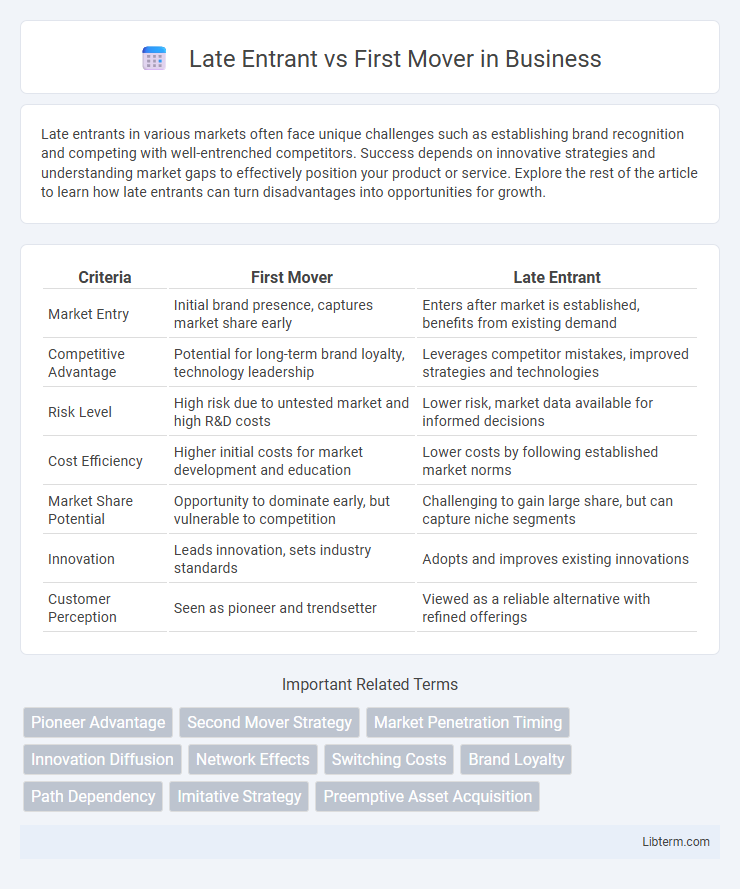Late entrants in various markets often face unique challenges such as establishing brand recognition and competing with well-entrenched competitors. Success depends on innovative strategies and understanding market gaps to effectively position your product or service. Explore the rest of the article to learn how late entrants can turn disadvantages into opportunities for growth.
Table of Comparison
| Criteria | First Mover | Late Entrant |
|---|---|---|
| Market Entry | Initial brand presence, captures market share early | Enters after market is established, benefits from existing demand |
| Competitive Advantage | Potential for long-term brand loyalty, technology leadership | Leverages competitor mistakes, improved strategies and technologies |
| Risk Level | High risk due to untested market and high R&D costs | Lower risk, market data available for informed decisions |
| Cost Efficiency | Higher initial costs for market development and education | Lower costs by following established market norms |
| Market Share Potential | Opportunity to dominate early, but vulnerable to competition | Challenging to gain large share, but can capture niche segments |
| Innovation | Leads innovation, sets industry standards | Adopts and improves existing innovations |
| Customer Perception | Seen as pioneer and trendsetter | Viewed as a reliable alternative with refined offerings |
Understanding Late Entrants and First Movers
Late entrants enter markets after first movers have established a presence, often leveraging existing market knowledge and customer feedback to refine offerings and avoid initial pitfalls. First movers gain advantages through brand recognition, customer loyalty, and setting industry standards but face higher risks and costs associated with market education and product development. Understanding the strategic trade-offs between late entry and first-mover status can guide businesses in optimizing innovation timing and competitive positioning.
Key Characteristics of First Movers
First movers leverage early market entry to establish brand recognition, secure customer loyalty, and set industry standards, often gaining a sustainable competitive advantage. They invest heavily in innovation and infrastructure, which can lead to high initial costs but also barriers to entry for competitors. Rapid market capture and the ability to influence consumer preferences are critical characteristics distinguishing first movers from late entrants.
Defining Late Entrant Strategies
Late entrant strategies focus on leveraging market insights gained from first movers to minimize risks and capitalize on proven demand. These approaches include rapid innovation, aggressive pricing, and niche targeting to capture market share efficiently. Effective late entrants often exploit technological advancements and customer feedback to outperform early competitors.
Advantages of Being a First Mover
Being a first mover offers advantages such as establishing strong brand recognition and customer loyalty before competitors enter the market. First movers can secure critical patents, control scarce resources, and shape industry standards, creating significant barriers to entry. Early market presence also allows for cost advantages through learning curves and economies of scale that late entrants may struggle to achieve.
Challenges Faced by First Movers
First movers face significant challenges including high initial costs, market uncertainty, and the risk of unproven demand. They must invest heavily in customer education, infrastructure development, and innovation without guaranteed returns. Competitors entering later can capitalize on first movers' mistakes, adopt superior technology, and refine marketing strategies to capture market share.
Benefits of Late Entrant Positioning
Late entrants benefit from observing first movers' market strategies and consumer reactions, allowing them to avoid costly mistakes and refine product offerings. They leverage established market demand and existing customer awareness, reducing marketing expenses and accelerating adoption rates. Access to advanced technology and improved processes enables late entrants to deliver superior value and quickly capture market share.
Risks and Limitations for Late Entrants
Late entrants face significant risks such as high entry barriers, established customer loyalty towards first movers, and limited market share availability. They must overcome the challenge of differentiating their products or services against well-entrenched competitors who benefit from brand recognition and economies of scale. The limitations for late entrants often include increased marketing costs and the potential for aggressive defensive strategies deployed by first movers to maintain market dominance.
Case Studies: First Mover vs Late Entrant Successes
First movers like Amazon capitalized on early e-commerce adoption, establishing strong brand loyalty and network effects that delayed late entrants' market penetration. Conversely, late entrants such as Facebook succeeded by learning from MySpace's failures, improving user experience and targeting underserved demographics to capture significant market share. Case studies reveal that late entrants often leverage innovation and agility to overcome first movers' initial advantages, highlighting the importance of strategic timing and market adaptation.
Industry Context: When Timing Matters Most
Late entrants can capitalize on industry insights and established market demand to strategically position their offerings, often avoiding costly mistakes that first movers face. First movers benefit from brand recognition and the ability to set industry standards, but they bear higher risks related to market uncertainty and consumer adoption. In fast-evolving industries like technology or fashion, timing influences competitive advantage, where first movers may dominate early but late entrants leverage rapid innovation and customer feedback to capture significant market share.
Choosing the Right Market Entry Strategy
Selecting the right market entry strategy depends on evaluating the advantages of late entrant versus first mover approaches. First movers benefit from brand recognition, market control, and customer loyalty, while late entrants capitalize on learning from predecessors' mistakes and leveraging advanced technologies. Careful analysis of industry dynamics, competitive landscape, and resource availability ensures alignment with long-term business objectives.
Late Entrant Infographic

 libterm.com
libterm.com